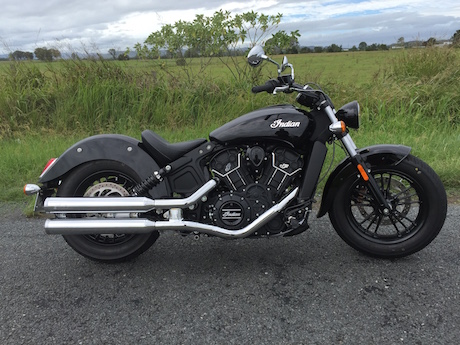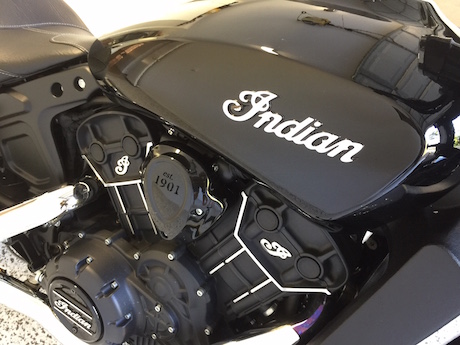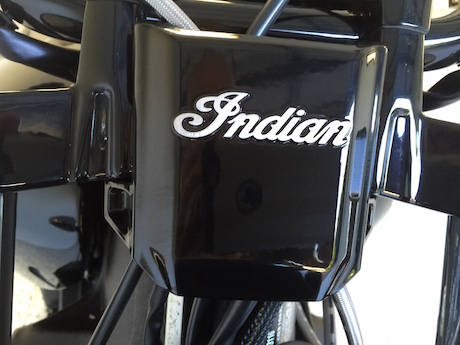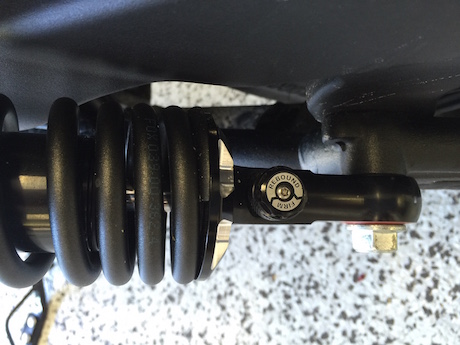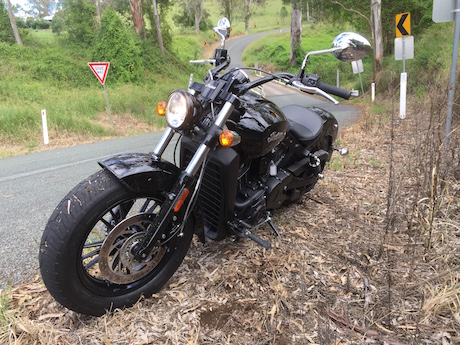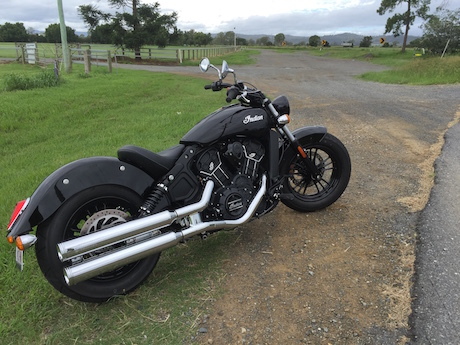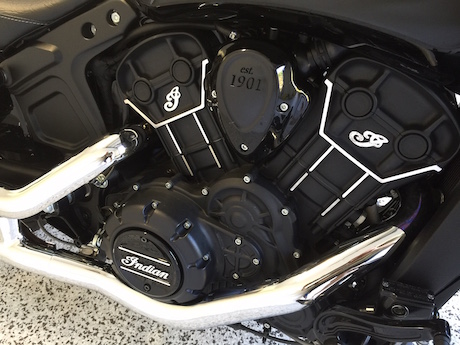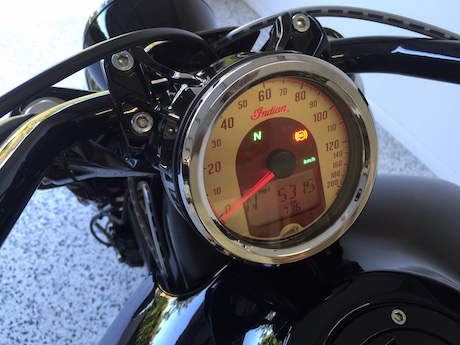The Indian Scout has quickly become the company’s biggest-selling motorcycle and now they have added the Scout Sixty with a smaller engine capacity and an attractive $2000 price advantage.
While most riders would argue there is “no replacement for displacement”, I would argue that the 999cc Scout Sixty is a more suitable package than its 1133cc bigger brother.
Apart from the engine size, one less gear and some cosmetic differences, they are basically the same bike.
The easiest way to tell them apart is from the all-black colour scheme and the missing “Scout” on the tank.
I reckon the all-black bike (engine, frame, bars, headlight, shocks, wheels and seat) looks much tougher than big bro with the grey frame, lashings of chrome and the brown leather seat. The missing “Scout” badge on the tank also makes it look neater.
Another “tell” is that the Sixty lacks the little “Indian” badge cover on the headstock that conceals the messy cables. The boys at Indian Motorcycle in Brisbane fitted one to my review bike for about $30 and it makes the bike look more complete.
The only problem with both Scouts is the rear shocks which are too soft and have no rebound.
However, the Scout Sixty is $2000 cheaper at $17,995 (ride away) so you can spend some of those savings on the suspension and end up with a better-performing bike for less.
The Brisbane boys know about my criticism of the rear shocks, so they fitted the review bike with Indian’s aftermarket fully adjustable shocks.
They totally transform the bike.
It now keeps its rear wheel on the ground which provides better braking and acceleration.
On the bigger Scout I had some troubles with the rear wheel locking up under rapid downshifting, but not so with the Sixty shod with the aftermarket shocks.
There is also no wallowing in corners and instead of bouncing over the lumps and potholes, sometimes hitting the bump stops, this bike sits solidly on the road and rides more comfortably.
At $1500 fitted, the shocks are an expensive addition to a non-performance bike, but there are some cheaper shocks available.
With the money saved, I would also stiffen the front end with a spacer to preload the springs and some heavier fork oil to slow down the bounce.
Adding to the comfortable ride is the vinyl seat, instead of leather. Indian did the same with the seat on the Dark Horse compared with the Chief. Vinyl might be cheaper, but it’s actually more comfortable.
Maybe the foam is a little thicker, too, because the Sixty’s seat is 643mm high, compared with 635mm on the Scout.
You now feel more in command of the bike with that slightly higher riding position.
Apart from engine capacity, the only other mechanical difference between the Scout and Scout Sixty is the transmission.
Instead of six speeds, it has five.
Fifth gear has been removed, but the transmission still has the same final drive.
It’s a refined transmission with neutral easy to find although the cable clutch pull is a little on the heavy side.
Top gear is not overdriven, so it’s a usable gear for highway overtaking yet there is not so much vibe in the engine that you keep searching for another gear.
Acceleration through the first four gears is similar to the bigger Scout and if you are still revving high in fourth leaping over the missing ratio to fifth, then you are exceeding the speed limit by a massive amount and heading straight to jail.
In normal riding, you won’t even notice the gap in ratios.
The Sixty noticeably lacks some of the top-end power of the bigger model (58.2kW compared with 74.4kW) but is down only 9Nm in torque which few people will notice.
On paper, it may look like a comparative weakling, but in the real world it is only noticeable with weaker throttle response at high revs.
But top-end power is not what cruising is about and at most points of the rev range, there appears to be very little difference in performance.
I thought the similarity in on-road performance was due to it being a lighter bike, but it weighs only 1kg less.
It’s still light and manoeuverable, but in tight spaces, the large turning circle is a problem.
Even though both Scouts have a single disc on the front, they have strong stopping power with plenty of feel in the levers thanks to braided steel cables, while the ABS works smoothly and efficiently.
The shapely mirrors are stylish, although they should perhaps be black to match the rest of the bike. They are also practical with no blur at any engine revs and a good view of the traffic behind you with no hint of your elbows.
Similarly, the mufflers would look better on the Sixty in black, rather than chrome. My test bike had stage-one pipes fitted which provide an angry sound.
The instruments on both Scouts are neat and tidy with an LCD screen showing a fair bit of information including gear selection, digital tacho, odo, trip meter, engine temp and a low fuel lamp.
You can conveniently scroll through the information menu via the button on the back of the left switch block.
However, it is disappointing that they haven’t included a fuel gauge or at least a range indicator.
The fuel light came on about 200km, which is not spectacular from the 12.5-litre tank, but I was giving it plenty of hard work.
It should be fine for most cruising, but if you are strapping on the optional screen, luggage and a pillion to do some touring, you will be stopping frequently at service stations.
Indian Scout Sixty tech specs
- Price: $17,995
- Warranty: 2 years/unlimited km, 2 yrs road-side assist
- Service: 800/8000km
- Engine: liquid-cooled 999cc 60-degree, DOHC, 4-valves/cylinder, V-Twin
- Power: 58kW
- Torque: 88.8Nm at 5600rpm
- Bore x Stroke: 93 x 73.6mm
- Compression: 11:1
- Transmission: 5-speed constant mesh; wet, multi-plate clutch, belt drive
- Fuel: 12.5 ltr
- Suspension: Telescopic forks, 41mm diameter, 120mm travel; twin shocks, 76mm travel, adjustable
- Wet Weight: 254kg
- Clearance: 135mm
- Length: 2311mm
- Rake/Trail: 29° / 120mm
- Seat: 643mm
- Wheelbase: 1562mm
- Brakes: 298mm floating rotor with 2-piston callipers; 298mm floating rotor with 1-piston calliper
- Tyres: 130/90-16 72H; 150/80-16 71H
- Wheels: 16” x 3.5”


